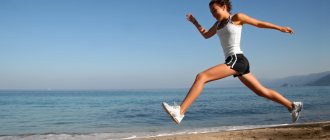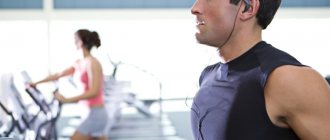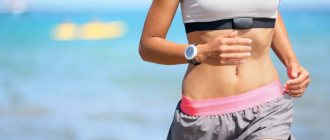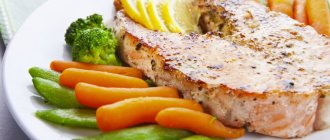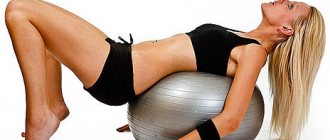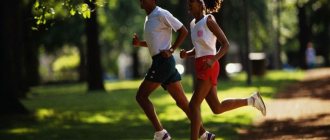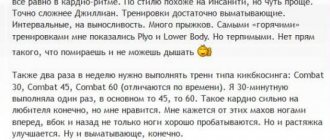Features of strength training on an empty stomach
Strength training on an empty stomach has its benefits.
Such activities trigger metabolism and maintain it at maximum level for a long time. A few hours after training, you will actively lose calories and burn subcutaneous fat. This will allow you to lose weight and get in shape much faster. Physical activity on an empty stomach increases energy potential, gives a charge of vigor and good mood for the whole day. They stimulate the release of endorphins, which improves the athlete's performance and training performance. Additionally, the level of somatropin and testosterone increases.
Regular exercise on an empty stomach increases willpower, helps develop discipline, dedication and concentration. They have a beneficial effect not only on physical health and body formation, but also help stabilize the psycho-emotional state.
If you decide to try your hand at fasted training, follow the basic rules:
- On the day of class, get up half an hour to an hour earlier to prepare yourself mentally and psychologically for the upcoming loads.
- To satisfy your hunger, drink plain water or mineral water without gases. The liquid will help the body wake up faster, start metabolism and dull the appetite.
- The duration of the training should be 40-60 minutes. With less time spent, you will not achieve the desired result, and in the case of a longer session, there is a high risk of developing a catabolic reaction and severe fatigue.
- During training, use as many muscles as possible. To perform exercises, use available exercise equipment and sports equipment with a feasible weight. However, avoid extreme fatigue, overtraining and complete depletion of energy reserves.
- Watch your breathing while doing the exercise: inhale while relaxing and exhale when tense. Improper or delayed breathing can lead to fainting, dizziness, low blood pressure, or loss of energy.
- At the end of the training, give your body some rest and recovery. This will avoid overtraining, fatigue, decreased motivation and stress.
- Start eating at least an hour after training. Delayed eating will allow you to burn more fat due to active post-workout metabolism. Breakfast should be enriched with protein and carbohydrates.
- To achieve maximum results, add cardio exercises to your strength training or alternate between aerobic and anaerobic exercise on an empty stomach every other day.
Strength training on an empty stomach does not promote muscle growth, but it does help you lose weight and, if necessary, “get lean.” This type of activity has a number of contraindications and side effects, so weigh the pros and cons before starting this type of activity.
Early Morning Strength Training: What You Need to Know
What to do if early morning is the only time you can go to workout? Are there any restrictions?
Early morning workouts and nutrition
In the morning after sleep, the body has low glucose levels. Exercising with low glucose levels can lead to temporary hypoglycemia - reducing it even further. You may feel nausea, weakness, dizziness and lightheadedness.
In the morning, the secretion of cortisol, a catabolic hormone, also peaks.
Cortisol is a stress hormone that provides glucose to the nervous system, extracting it from body proteins and fats.
The cortisol antagonist is insulin. When insulin levels rise, cortisol decreases. So eating something before going to work out is a good idea. In addition, research shows that carbohydrates and proteins eaten immediately before a morning workout have a greater anabolic effect. It is slightly higher than eating before a daytime or evening workout, when amino acids, fats or glucose from previous meals are already in the blood.
Some people don't like to exercise on a full stomach. They feel heaviness and drowsiness, and it is more difficult to exercise. In fact, it takes very little to raise blood glucose. Lyle MacDonald gives the following figures:
- 0.3-0.4 grams of both protein and carbohydrates per kilogram of body weight. For a girl weighing 55 kg, this is 16-20 grams of both.
So you don't have to binge on breakfast before your workout if you don't want to. In this case, food in liquid form would be a good solution: it is absorbed faster and does not create a strong feeling of fullness and heaviness in the stomach. Milk, yogurt, protein powder, fruit may help. The stomach will not be full, but the body will receive everything it needs.
Early morning workouts and joints
Your joints are immobile while you sleep. During this time, the production of synovial fluid decreases. This fluid lubricates the joints to help them move freely. In addition, the body temperature is lower in the morning, and this also makes the muscles and ligaments more rigid. Therefore, a quality warm-up is very important.
Morning workouts and spine
There are studies that most people show better results in training 3 hours after waking up. During this time, you warm up in various everyday movements, your joints restore elasticity and mobility. But not everyone can afford it, which can be a problem. Dr. Stuart M. McGill writes about this in his book Ultimate Back Fitness and Performance.
When you sleep in a lying position, the compression (squeezing) load on the intervertebral discs decreases. This allows the discs to absorb more liquid and expand in volume. In the morning, the pressure inside the discs is 240% higher than before bedtime, and the likelihood of protrusions, hernias or damage to the ligaments increases at this time. If possible, avoid heavy deadlifts, Romanian deadlifts, and squats if you're training less than an hour after waking up.
During the day, excess water comes out as a result of normal household load. The discs become more rigid in compression, but at the same time more flexible. The likelihood of them being damaged becomes less.
If you don't have the option to wait a couple of hours after getting up before exercising, here are some solutions. They reduce the risk of spinal injuries during morning exercise.
1
Hot shower or sauna
This is one of the passive warm-up methods - a way to warm up soft tissues and make them more elastic.
2
Longer warm-up
The longer you warm up and stretch, the more excess fluid will be released from the discs before you begin strength training. Running fast early in the morning without preparing the body is also not recommended. The best option is walking on a path uphill, joint warm-up and dynamic warm-up for the mobility of the main joints. If you usually warm up for 10 minutes, double the time.
3
Do warm-up sets
Don't start straight away with heavy barbell exercises. Instead, do a longer series of warm-up sets with light weights.
4
Do one-legged exercises
Give preference to exercises performed on one leg. Lunges, split squats, step-ups, single leg rows, etc. In them, the load on the lower back is less, and the activation of the target muscles is just as good.
5
Abdominal exercises - at the end of the workout
Flexion-extension of the spine is especially dangerous when the discs are oversaturated with water. Even safe exercise can be harmful under these conditions. Therefore, do all crunches at the end of your workout.
Correct technique and types of exercises
If you want to hear the answer right away, it will be “Yes”
Does this mean all the talk about pre-workout nutrition was in vain? Not really.
Some studies have shown that consuming carbohydrates before exercise allows athletes to exercise longer than when training in a fasted state.
Another study found that men in a fasted state ran significantly shorter distances in 60 minutes. Compared to men who ate pre-workout. This was despite no significant differences in heart rate and perceived exertion.
But while not eating before a sporting event will not help you achieve outstanding results, training on an empty stomach for amateur sports can help in other ways. Especially for those who care more about their waistline than their marathon results.
Another of the many studies conducted on this topic concluded that men aged 18-25 who did fasted cardio exercise while eating a high-fat, high-calorie diet had improved glucose handling and insulin sensitivity compared to those who exercised without refusing food before exercise or those who did not exercise at all.
Of these three groups, only those who did the exercises on an empty stomach did not gain weight.
The question of whether you should practice exercises on an empty stomach to lose body weight is not as clear-cut as it seems. Although it seems that everything is simpler than that: after skipping a meal, the body has nowhere to get energy and it begins to take it by burning fat.
For example, a study at the University of Bath in the UK found that when overweight people briskly walked for 60 minutes on an empty stomach, their bodies switched to increased burning of stored fat (not carbohydrates) compared to the group that ate before. training.
“Overweight people respond differently to fasted exercise—they typically increase their metabolic rate faster than healthy people,” says Darrin S. Willoughby, Ph.D., director of the Exercise and Biochemical Nutrition Laboratory at Baylor University in Texas. .
This is confirmed by the British Journal of Nutrition, reporting findings from a 2013 study. When exercising on an empty stomach, people lost 20% more fat than people who had a small snack before exercise.
Another experiment published in the International Journal of Sports Nutrition and Exercise Metabolism found the same result: Fasted aerobic exercise reduced body fat percentage more than pre-workout meals.
Sports nutritionist Kelly Pritchett. “Why is excess fat burned?” - he reasons. “To perform intense physical activities such as long-distance running or weight lifting, your body must burn glycogen, or stored carbohydrates. If it used them, then there must be a power switch.
Presumably due to the excess fat that you have. But there's one catch. Your body is not a fan of exercise, and as you quickly burn fat, your body begins to regulate its metabolism and burn fewer calories. Your body goes into survival mode and uses more nutrients to store energy in the form of fat at your next meal.”
Also cited is a study published in the American Journal of Clinical Nutrition, which showed that prolonged fasting can in some cases cause a drop in the body's metabolic rate.
In this case, we can draw the following conclusion. Each theory has its supporters and opponents. But the theory of fasting training has enough followers who show its effectiveness. And if you're concerned about losing weight, the best way to find out if fasting exercise is right for you is to try it yourself and decide whether it helps you or not. After all, a person is individual and what does not suit one may perfectly help another.
And if, after all of the above, you ask me “is it possible to eat before training”, I will answer “Yes”. It's okay to eat, but if you try fasted workouts, you'll be able to find out exactly what's best for you.
Professional athletes always monitor the technique of performing exercises and complexes. Failure to follow the rules is unlikely to lead to benefit, but on the contrary, it can cause harm.
By adhering to the required execution scheme, you will get:
- Load efficiency.
- Protection from damage.
- More endurance.
For beginners, to learn the correct technique, you can seek help from a fitness trainer or watch videos that are freely available on the Internet.
How to exercise on an empty stomach and not harm the body?
As we already know, there are two main types of physical activity: strength and cardio.
Strength training is mainly used to build muscle mass, and cardio training is used to improve metabolism, increase endurance and lose weight. If you exercise on an empty stomach, it is better to choose a cardio load, since it has been proven that this type of exercise promotes the release of adrenaline, which enters the blood during exercise and triggers the breakdown of carbohydrates and fats for use as fuel.
I don’t think that you can exercise with a barbell or dumbbells on an empty stomach, for this you at least need strength and vigor, but running or doing aerobics in the morning is the best thing. Scientists have proven that it is better to do strength training in the afternoon, since after such stress the muscles continue to burn calories for some time.
Amount of load.
The intensity of the workout is also important. To get the most out of a fasted workout, you need to train at a medium pace, not a fast pace, and for at least 45 minutes. The higher the intensity of the workout, the more the body will use carbohydrates rather than fats as energy, since the ratio between inhaled oxygen and exhaled carbon dioxide is disrupted. Therefore, the duration of the workout is important, not the high tempo .
Why 45-60 minutes is the time when the body releases its reserves and does not try to preserve itself. There is no need to overdo it, do not forget that physical activity is a load that primarily falls on the heart muscle and vascular system; there is no need to subject them to terror once again.
Amount of carbohydrates consumed.
There is another important factor that will make your weight loss and training in the morning more effective, this is reducing the consumption of carbohydrates in the evening. Why is it important? When we spend our energy during physical activity, the body takes energy from carbohydrates for the first 30 minutes, and then uses fat reserves. This is how the human body is designed to survive in the most extreme situations. But if we prepare our body in the evening and saturate it with a small amount of carbohydrates, then in the morning when training on an empty stomach, we will get the maximum benefit.
For dinner, you can use a group of vegetables that has no more than 3-6% carbohydrates. This group includes:
- cabbage,
- beet,
- tomatoes,
- radish,
- cucumbers,
- greenery,
- pumpkin,
- carrot,
- onion.
Fruits should not be eaten in the evening, as they are high in carbohydrates and are considered an excellent energy resource. Limit fruit intake to 250g per day and not in the evening.
It is very difficult to train on an empty stomach, since the body has not received its portion of energy in the form of various foods. I felt this myself and found a solution. When I wake up, I drink a glass of water, and 10 minutes later a small cup of hot, weak tea or coffee without sugar. This gives me the strength to dance for 60 minutes.
I hope that my article has convinced you that doing aerobics or any cardio exercise at an average pace and lasting 45-60 minutes on an empty stomach, that is, on an empty stomach, will bring you health and benefits. Before exercising on an empty stomach, if you have any diseases, be sure to consult your doctor.
Articles on related topics:
- How to lose weight and not lose muscle mass.
- Diet and exercise.
- How to burn calories to lose weight?
- The secret to a beautiful figure is the right habits.
We recommend reading
Tags: physical activity, training
Add a comment
Contraindications
If you do not have certain physical abnormalities and you feel excellent, then you can safely start morning sports activities. There is no need to be afraid of consequences in the form of health problems in your case.
If you have problems, you need to consult a doctor. He will be able to tell you which exercises you can do and which ones you should avoid.
Basically, there are no strict contraindications to morning exercises. Almost every person is able to perform simple exercises.
There are the following restrictions:
- A cold that is accompanied by high body temperature.
- Presence of bleeding.
- Inflammation.
- Problems with normalizing blood pressure.
- Presence of malignant tumors.
- Kidney diseases.
Despite the list of benefits, many coaches and athletes are against fasted training. This is due to physiological processes and changes occurring in the human body.
During training on an empty stomach, the athlete obtains the necessary energy from lipids, since there is no sufficient supply of glycogen. However, quite often strength training leads to protein burning and muscle depletion, which causes the opposite effect from the desired one. In this case, training not only becomes useless, but can also lead to regression.
Quite often, athletes who train on an empty stomach complain of digestive problems and the development of a number of problems. Stomach pain, stool disturbances, heaviness and bloating occur.
Strength “hunger” exercises have a number of contraindications. So, you should not use this kind of load if waking up early does not bring joy, but causes stress. Training on an empty stomach is contraindicated in the presence of chronic diseases of the gastrointestinal tract, insomnia, or if a person does not adapt well to changes in eating habits and daily routine.
This type of activity is strictly prohibited for women during pregnancy and lactation, people with diabetes and liver disease. Before you start exercising, consult your doctor.
Insulin
Insulin is a hormone that regulates the use of nutrients by the liver, body muscles and fat cells. Insulin is produced in response to carbohydrates entering the body. Every time you eat a banana, chew a carrot, swallow a sandwich or drink juice, your body produces insulin, which controls the absorption of nutrients.
Insulin thus helps control fat cells and food absorption. And lack of sleep, lack of mobility (or a sedentary lifestyle without exercise), and overheating of the body make our bodies less sensitive to the effects of insulin. This so-called insulin resistance makes us more prone to diabetes, certain types of cancer and obesity, which is a major health problem in developed countries.
If you decide to exercise when most of the glucose and glycogen from your last meal has been used up, your body is likely to turn its attention to fat cells as an energy source. After fasting, your body becomes most sensitive to the insulin it produces whenever you eat. This sensitivity does magical things - it uses carbohydrates, proteins and fats more efficiently, promoting body muscle growth and fat burning.
One of the explanations why the topic of insulin resistance has become such a hot topic today is the theory of “thrifty” genes. She states that our metabolism speeds up when we consciously vary periods of eating and fasting, vigorous exercise and rest. This is in stark contrast to the lifestyle of the modern average person with his sedentary lifestyle, abundance of food and constant consumption of it.
A growth hormone
In fact, opinions about this hormone are mixed. It is present in the bodies of children and adolescents and is declared as an anti-aging factor for older people. But while its effectiveness against aging has not been confirmed, it directly affects the growth of muscle mass and increased muscle strength. Daily fasting can increase the production of growth hormone in the body by 1.5 times.
Testosterone is one of the hormones that directly affects the increase in muscle mass and burning fat in the body. And it is precisely because of this that the answer to the question of whether it is possible to do strength exercises on an empty stomach can only be in the affirmative. With a short-term refusal of food, the effectiveness of strength exercises increases several times.
The effectiveness of cardio on an empty stomach
Cardio exercise is, first of all, a load aimed at training the heart muscle and only then at losing weight. It can be put even more simply: losing weight is a by-product of training the heart muscle.
After a night's sleep, catabolic processes prevail in people:
- the cycle of fermentation of products in the intestines ends;
- the heart muscle is in a state of relative rest;
- the nervous connection between the central nervous system and muscles is restored;
- the cycle of synthesizing new amino acids in the body ends;
- glycogen reserves are partially depleted.
In other words, our body is completing a reboot associated with building basic functions. But all this requires energy. Since, when general metabolic processes slow down, the body has no external sources of energy, it uses its own glycogen reserves, depleting them almost to zero. At the same time, incompletely synthesized amino acids can easily perform the function of energy elements, breaking down into the simplest glucose under the slightest stress.
Cardio exercise, regardless of its type, is aimed at working specifically with glycogen reserves. If the body does not find them, it begins to burn fats. However, this does not happen immediately, but only in the complete absence of easily split energy elements.
Therefore, when a person starts running in the morning without eating beforehand, the following processes occur:
- First, the glycogen reserves accumulated by liver cells overnight are depleted.
- The breakdown of amino acids circulating through the blood into the simplest energy elements begins.
- Growth hormone is released in large quantities.
- Only after this does the breakdown of the fat layer begin.
This process has positive and negative sides. Among the advantages is the abundant release of growth hormone, which causes muscle hyperplasia, which increases their energy and strength potential in the future. The main disadvantage is that before burning fat, the body breaks down its own muscles, which are in a semi-disassembled state. This happens because from the point of view of optimization processes this is a simpler path.
If you want to lose weight, morning cardio will help you burn fat and muscle faster. But if your goal is to maintain the muscle mass you have gained, or in addition to morning cardio, you plan to do an evening training set, then morning cardio on an empty stomach is contraindicated for you.
What doctors say about morning workouts
To begin with, let us draw your attention to the fact that after waking up, the human body remains at rest for another three hours. Exercising in the morning helps all muscle groups fully awaken.
The advantages of this time for activity include:
- Exercise is an impetus for increasing blood circulation, which, in turn, will be an excellent incentive for work.
- Exercising at this time promotes muscle growth.
- In the morning, excess fat is burned more actively, since the body has not yet received a dose of food and energy is taken from stored reserves.
- Physical activity on an empty stomach does not slow down metabolism; its speed still remains at the same level for a certain time after the completion of the activity process. It turns out that excess deposits continue to burn even after training.
May have negative effects on the heart and blood vessels. During sleep, the body is at rest; activity increases blood pressure and, accordingly, the heart rate. A weakened heart will not be able to cope with pumping blood;
- Exercising before meals can negatively affect the functioning of some internal organs.
- After any type of exercise, our body needs nutrients. There comes a feeling of extreme hunger, which can subsequently lead to overeating.
Any medical professional can confirm that in the absence of contraindications and in good health, exercise in the morning will only bring benefits and a great mood.
Doctors say that physical activity in the morning will help you recharge your batteries for the whole day, increase your appetite and strengthen your body.
Features of morning workouts
They have the following differences.
Longer warm-up
At night, the body is in an immobilized state, so, for example, the fluid that lubricates the joints for free movement is not released. Plus, body temperature in the morning is lower than throughout the day, so muscles and ligaments are a little stiff . To avoid injury during exercise, you need to warm up thoroughly before training.
Be sure to have breakfast
It has already been said about the need to eat before training.
If you do not restore the balance of sugar in the body, the athlete will quickly feel tired and will probably not be able to perform a full range of exercises.
Therefore, you definitely need to have a snack in the morning.
Faster pace of training
If you give your body the necessary proteins and carbohydrates before training, you can load it a little more. In addition, the athlete will not be as tired as in the evening after a working day.
Limit weight
During morning workouts, it is not recommended that exceed the body’s normal weight.
Attention! If an athlete is unable to lift sports equipment more than 5-6 times, the weight is considered too much for the body. Such activities should be limited.
Protein
After these facts, you may be thinking, “even if exercising on an empty stomach is beneficial in the short term, does fasting affect protein digestion and muscle mass?” In fact, studies in young, middle-aged, and elderly adults have found that you can take your daily dose of protein at one time without harmful effects.
In general, if you are not an athlete, then your strategy can be quite simple. If you don't want to eat, then don't eat.
Speaking about training on an empty stomach, we can say the following: skipping one or two meals before training will not harm your body. Intermittent fasting can reverse the effects of a sedentary, high-fat, high-calorie diet and make more efficient use of the food you eat. Working out in the morning on an empty stomach will help you better absorb the foods you eat after your workout.
What to eat before morning cardio
For a successful workout, you need to think not only about what to eat, but also how much breakfast you need to eat. The main purpose of eating breakfast before training is to load the body with carbohydrates to increase the effectiveness of the training process and improve the body's energy production process.
Accordingly, you should eat only high-quality, slow carbohydrates or proteins. Fat is an untouchable reserve of the body, and it will be very reluctant to part with it. Therefore, for professional athletes, it would be better to take a small protein meal. Otherwise, muscle mass will be processed along with fat to replenish energy reserves.
When we say small quantities, we mean very small portions indeed. About a third of the standard.
Nutrition before and after training
Some people prefer to train on an empty stomach, while some people like to eat a light meal before training. It all depends on the capabilities of each person. Those who prefer to exercise first, and then eat, must observe a time interval of about 20-30 minutes between processes.
If you feel dizzy and have no strength for physical activity, then in this situation it is better to eat a light breakfast half an hour before training.
Below we will discuss in more detail what you can eat depending on the time indicator.
Let's figure out what you can eat before physical activity.
Your diet should consist of protein foods and carbohydrates. Fats are not recommended for consumption. Fatty foods take a long time to digest in the stomach, which can cause pain, nausea, etc. Carbohydrates supply our body with a boost of energy, which will be consumed during exercise. Protein foods are the main sources of substances such as amino acids necessary for muscle function.
After physical activity, eating should not be delayed for long. The effectiveness of the exercises will be reduced. All the substances that the body receives during this intake will be used to restore the condition of the muscles and increase their mass. There will be no deposits in the form of fat.
What can you eat?
Carbohydrates can be taken in liquid form, such as grape juice. It is very important to eat protein foods after physical activity. The correct dosage is calculated based on the size of your palm - the food should fit in it, no more. Since the purpose of morning exercise is weight loss and muscle gain, you should not eat fatty foods. For example, if you plan to eat chicken, give preference to fillet. You can eat egg whites, not very fatty cottage cheese.
If you are faced with a choice of red meat, then dietary veal is an excellent option. You should eat fatty fish more often; it can be baked in the oven or steamed.
Coffee lovers are better off taking a two-hour break after exercise. This is what a sample menu looks like.
Sports nutrition helps the body receive all the necessary active supplements, taking into account daily training. It cannot replace a healthy diet, but is only a complement to it.
There are the following main types:
- Protein. These are protein-rich foods. They contain a minimal amount of carbohydrates. This diet is intended for both weight loss and muscle gain. This is a great option for snacking between meals.
- Gainer. This is a mixture consisting of proteins and carbohydrates. Helps build muscle and restore energy after a workout.
- Fat burners. They will only help in combination with physical activity. Accelerate metabolism;
- Amino acids. Such sports nutrition will help restore muscle condition and reduce soreness.
- Energy. Gives energy during strength training, adds endurance;
- Vitamins. Helps increase stamina and strengthen the immune system. Accepted as a course.
- Carbohydrates. After training, you can include fast carbohydrates that have a high glycemic index in your diet. Energy drinks and gels are suitable, and you can also purchase special bars.
Is it possible to do strength training on an empty stomach?
After waking up, glucose is at a fairly low level. Training can reduce it even further.
And this, in turn, will lead to dizziness, nausea, and fainting. In addition, strength training requires a lot of energy, which needs to be replenished early in the morning.
And also in the morning, insulin , which is undesirable for the normal functioning of the body throughout the next day.
Therefore, one conclusion suggests itself: you need to have a snack before starting your morning strength training and try, if possible, not to exercise on an empty stomach. No one talks about the fact that you need to eat your fill so much that then it’s hard to train and makes you sleepy.
Experts recommend eating foods rich in proteins and carbohydrates , which, by the way, have an increased anabolic effect during strength training in the morning.
Nutrition tips
The best food before classes is liquid . It is easier to digest, digests faster and does not leave a feeling of heaviness, but at the same time it saturates the body with everything it needs. Eat, for example, yogurt, fruit, milk or a protein shake .
Experts give the following figures: 0.3-0.4 grams of proteins and carbohydrates per 1 kg of body weight. This is enough for physical activity to be effective and not lead to negative consequences.
Example workout
Let's take a closer look at the main types of exercises for morning exercises, depending on where they are held.
At home
The program may include:
- Cardio training. This includes running, jumping rope, and energetic types of dance elements. A 15 minute run will be enough.
- Exercises for the upper region (arms, chest and back). Push-ups from a wall or floor, lifting your arms with weights at different body positions.
- Exercises for the abs. This could include crunches, a “climber” exercise, leg lifts from a lying position, or a static plank.
- Complex for the lower body (legs and buttocks). Popular types are squats, bent and straight leg abductions.
An example of a morning program at home:
- 1 exercise - jump rope: 3 sets of 1 minute (break no more than 20 seconds).
- Exercise 2 - push-ups: 3 sets of 10-15 times (break 20-30 seconds).
- Exercise 3 - static plank: 3 sets of 1 minute (rest 30 seconds between sets).
- Exercise 4 - squats without weight: 3 sets of 20 times (break 20 seconds).
- 5 final exercise - 1 minute of jumping rope.
In the gym
While in the hall, you can use all the equipment provided. For example, weights and dumbbells, balls, hula hoops, treadmills, orbitracks, etc.
The following exercises are suitable for men:
- Dumbbell press in any body position.
For women and girls you can use the following complex:
- In order to remove fat on the stomach and sides, you can use cardio equipment. Every gym has treadmills and cycling tracks.
Training Tips
In order to achieve the desired result, you must follow a number of rules. We have collected some useful tips for you.
Warm-up and stretching
Be sure to do a warm-up before training. This includes jumping and running. This helps warm up the muscles and increase blood circulation in the vessels. It is thanks to the warm-up that your muscles will be ready for physical activity, and the ligaments will not be damaged.
After finishing, it is also worth doing some stretching, this helps to quickly restore the muscle structure.
Initially, 1-2 approaches will be enough. The exercise must be repeated 10-15 times in one approach. Then you can increase the number of approaches and repetitions depending on your capabilities.
Equipment
All exercises should be done only in special sportswear and shoes. This also applies to home workouts. Such equipment allows you to quickly remove sweat and provide access to air. Sneakers will help protect your feet and knees from damage.
For beginners, the first classes should start with 20-30 minutes, then you can gradually increase them. You can eventually work your way up to 60-90 minutes of vigorous exercise.
To begin with, you need to start with 2-3 times a week. Once your body is stronger and your endurance is higher, you can begin daily exercise.
Common mistakes
The most common mistake is poor nutrition. This should not be done; you need to eat right and drink properly, adhering to the calculated dose for weight loss.
Stopping training after not getting immediate results. The scales will not show you minus right away; here you need to show perseverance and determination. It is better to take photographs over a period, for example, once a week. You can see positive changes from them.
Most people focus on one type of exercise. This is not correct; it is necessary to work out each muscle group.




